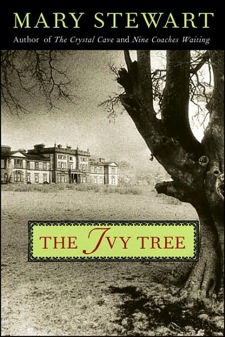Mary Stewart’s The Ivy Tree (1961) is another double identity novel. Stewart clearly has read and been influenced by Brat Farrar (post), because she has the characters read it and deliberately imitate the methods used in it. This was published as romantic suspense, or gothic, like a lot of Stewart, and that’s the way it reads. There’s a girl and a house, and the girl’s reward and meaningful relationship is the house. There’s a dark handsome villain and a wounded hero. There’s a lovely bit with kittens. Unfortunately, I can’t say anything about what makes the book worth reading without spoilers, and even more unfortunately it is a book that is spoiled by the spoilers.
The book looks as if it’s essentially doing a replay of Brat Farrar in a romantic key, with a girl instead of a boy and a mystery in the past. It’s possible to enjoy it the first time as just exactly that—walking the tightrope, deceiving everybody, finding out what happened in the past. But in fact it’s doing a double reverse whammy and the girl turns out to be the real girl and not a double at all—the real girl pretending to be her own double. The first time I read it I the reveal knocked my socks off. But the reversal is pretty much the only reason to read this, unless you’re unutterably fond of gothic novels, and yet once you’ve revealed the fact of the reversal the book is spoiled and really much less enjoyable.
Re-reading it with the knowledge that Annabel is the real Annabel, it’s impossible not to conclude that it cheats. The book is written in first person, and it does cheat in what she tells you, the way she tells it, when it’s told. In third it wouldn’t be a cheat, but this is a romance novel, all first person and heaving emotions. It carefully doesn’t actually cheat except by omission, but goodness me it omits very judiciously. Agatha Christie’s first person murderers pretending to be detectives are writing deliberately to fool the reader when they say “I did what few things had to be done”—who is Annabel supposed to be writing to? This is typical Stewart brain-dump first, and that isn’t something that works well with a deceptive narrator.
It’s very clever indeed, too clever for its own good. For example, the real Annabel was supposed to be a wonder with horses, so the fake “Mary” says she is afraid of horses. She’s in a field with a horse when her grandfather tells her something that upsets her, she goes white and backs against the rail with the horse in front of her, her grandfather says he’d think she was afraid of the horse if that wasn’t impossible, she’s saved by Con, her cousin and supposed co-conspirator, who is in fact the person she’s fooling by doing the impersonation. The truth is that it’s what her grandfather said that upset her, but you believe along with Con that it’s the horse. This is from inside her point of view, and there’s lots and lots of stuff like this where she gives us her own reactions from inside but without explaining what they’re reactions to. Half the book is this. It’s a completely different book if you know what’s going on—and unfortunately, not such an enjoyable one.
As far as the plausibility of the deception goes—it’s good. Annabel has been away for years, a close resemblance in a stranger with ancestors from the area isn’t impossible. Everybody says how much thinner and older she looks, especially in comparison with her cousin Julie, who is also nearly identical. It’s plausible as a set of looks people have—especially as she’s conventionally beautiful. The reasons for the impersonation are that the grandfather has refused to change his will, that Con wants to inherit the farm and, having found her (and read Brat Farrar) he wants to bring a false Annabel to help him. Con’s motivations seem plausible, and so does Annabel’s as long as she isn’t Annabel—financial security. Her motivations as Annabel in pretending to be herself so that she can go home and Con won’t kill her are odder, but not entirely beyond belief. It is weird though, it’s the kind of thing that when you stop to think about it you’d probably be able to think of a better way of doing it.
As far as psychological realism goes, this isn’t in the same league as Brat Farrar, never mind The Scapegoat. It’s a load of nonsense, really—and the cat stealing the sandwich and the terrible dinner party don’t really make up for it. Adam, the romantic hero, is hardly characterised at all. Except for the conventions of the romance genre he wouldn’t exist. It has the house, the servants, the family, the landscape—but it’s a fairly shallow book all the same.
If you would like to read a Mary Stewart gothic, I recommend Nine Coaches Waiting, which is a nearly perfect example of its kind. The Ivy Tree is for double identity and Stewart completists.
Jo Walton is a science fiction and fantasy writer. She’s published eight novels, most recently Half a Crown and Lifelode, and two poetry collections. She reads a lot, and blogs about it here regularly. She comes from Wales but lives in Montreal where the food and books are more varied.










